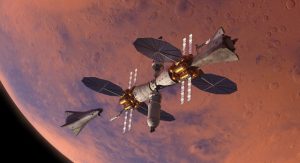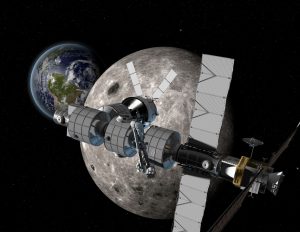A lot happened this past month in outer space. Of course the biggest story in September was the end of the Cassini mission to Saturn as the spacecraft plunged into the planet’s atmosphere. I’ve already talked about that however (See post of 13Sept17), so in today’s post I’ll be talking about several other items of interest.
The first story I’m going to discuss also concerns one of NASA’s interplanetary space probes. The Osiris-Ex mission is an ambitious attempt to land on the asteroid Bennu, collect a sample and return that sample to Earth. The picture below shows an illustration of the Osiris-Ex probe hovering above Bennu taking a sample.

The Osiris-Ex spacecraft was launched last year and placed on a trajectory that initially took it closer to the Sun. That orbit was designed to bring the probe back around for a gravity-assisting flyby of Earth. On 22Sept17 the spacecraft flew 17,500 km over Antarctica not only boosting its velocity by 3.7 kilometers per second but altering the plane of its orbit around the Sun to match that of Bennu.
The Earth flyby was accomplished without a hitch and as it moved past our planet the spacecraft took several pictures of Earth, one of which is shown below. Osiris-Ex is now expected to reach Bennu in October of 2018. Once in orbit around Bennu the probe will spend two years mapped and examining the asteroid with a variety of instruments before reaching out with a robotic arm to try to grab a sample of as much as two kilos of material from Bennu. The spacecraft will then leave Bennu for a return to Earth carrying that material. The expected arrival date for the sample is September of 2023.

Long range planning is key to the success of any space endeavor. With that in mind Lockheed-Martin Corporation (known in the aerospace industry as Lock-Mart) has published some details and illustrations of their ideas for a Mars Base Camp program. Lock-Mart’s plan calls for a space station to be built in orbit around Mars which can then be visited by astronauts from Earth. Four of the astronauts can then take two week long excursions down to the Martian surface using a single stage Mars Assent / Descent Vehicle (MADV). The illustration below shows what the Mars station could look like in orbit around the red planet.

The MADV lander is intended to land on the Martian surface using the supersonic retropropulsion technique that Space-X Corporation has developed to land their Falcon-9 rockets for reuse. The illustration below shows the MADV sitting upright on the surface of Mars.

Perhaps the thing I like best about Lock-Mart’s scheme is how it looks and feels so similar to the hardware Andy Weir described in his novel “The Martian”
Another important news item this month concerns President Trump’s finally making his choice for a new director of NASA. This month Trump chose Oklahoma Congressmen James Bridenstine for the job. Now Trump’s choice is controversial for several reasons first and foremost of which is the fact that, unlike every NASA director since the agency’s founding, Bridenstine has no background in either science or engineering. The picture below is of Congressman Bridenstine.

The congressman is also well known for several opinions that have put him at odds with the majority of the scientific community. The most notable of these is global warming with Bridenstine being a consistent climate change denier.
On the other hand Bridenstine is a strong supporter of human exploration of space. He also is on record as preferring a return to the Moon before going on to Mars, a position I have advocated in several posts (22Feb17 and 19July17). Bridenstine is also a strong supporter of the commercialization of space by companies such as Space X and Orbital Science.
Only time will tell whether Congressman Bridenstine turns out to be a good choice for NASA. More than anything else NASA needs a coherent long term goal, and then to stick to that goal. I’m actually more concerned about the incoherence of Bridenstine’s future boss than I am about Bridenstine.
My final item is also more political than anything else. After the successful cooperation between the US and Russia in the building and operation of the International Space Station the two nations have agreed this past week to cooperate on the construction of a space station in lunar orbit, the Deep Space Gateway project. The picture below shows what the Deep Space Gateway project could look like.

If that concept sounds familiar well of course its really the same plan as the one from Lock-Mart we discussed above for Mars. I suppose the idea is to take human exploration one step at a time, using the knowledge and technology gained in the last step to ensure the success of the next step. That could all be for the best but we will still need definite goals and a firm commitment from those who hold the purse strings if we’re going to finally return to truly exploring outer space.
